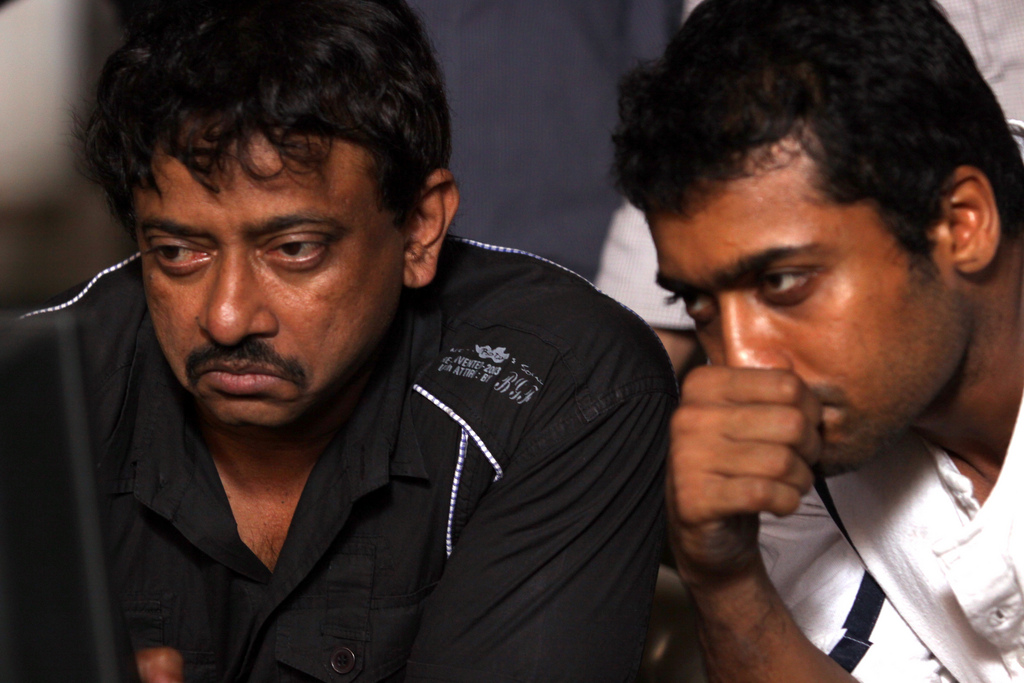|
Satya (1998 Film)
''Satya'' () is a 1998 Indian Hindi-language crime film, produced and directed by Ram Gopal Varma; written by Saurabh Shukla and Anurag Kashyap. It stars J. D. Chakravarthy, Urmila Matondkar and Manoj Bajpayee, alongside Saurabh Shukla, Aditya Shrivastava and Paresh Rawal. It is the first of Varma's Gangster (film series), '' Gangster'' trilogy about organised crime in India. The film follows Satya (Chakravarthy), an immigrant who comes to Mumbai looking for a job, befriends Bhiku Mhatre (Bajpayee) and is drawn into the Mumbai underworld. Varma, initially planned to make an action film, but decided to make a film focusing on felonies after meeting some criminals. He hired Kashyap and Shukla to write the film, and opted to use lesser-known actors. The soundtrack and score were composed by Vishal Bhardwaj and Sandeep Chowta, respectively, while the lyrics were written by Gulzar. Its early cinematography was done by Gerard Hooper, who was replaced by Mazhar Kamran. The film was sho ... [...More Info...] [...Related Items...] OR: [Wikipedia] [Google] [Baidu] |
Ram Gopal Varma
Penmetsa Ram Gopal Varma (born 7 April 1962), often referred to by his initials RGV, is an Indian film director, screenwriter and producer, primarily known for his work in Hindi cinema, Hindi and Telugu cinema, Telugu films.** * * Varma has directed films across multiple genres, including parallel cinema and docudrama noted for their gritty realism (arts), realism, technical finesse, and craft. Regarded as one of the pioneers of new age Cinema of India, Indian cinema, he was featured in the BBC News (international TV channel), BBC World series ''Bollywood Bosses'' in 2004.* In 2006, Grady Hendrix of Film Comment, published by the Film at Lincoln Center cited Varma as "Bombay's Most Successful Maverick" for his works on experimental films.* * He is known for introducing new talents, who eventually become successful in the Indian film industry. Starting his career as a civil engineer, he made an entry into Telugu cinema with the path-breaking crime thriller, ''Siva (1989 Telugu fi ... [...More Info...] [...Related Items...] OR: [Wikipedia] [Google] [Baidu] |
Gangster (film Series)
''Gangster'' is an Indian Hindi and Telugu-language crime thriller franchise written, directed and produced by Ram Gopal Varma. It is based on the Indian mafia organization D-Company, known to be run by Dawood Ibrahim. The first film came in 1998: the critically acclaimed '' Satya'', later followed by '' Company'' and then the prequel '' D'', with storylines based on the Mumbai underworld. ''Satya'' has won six Filmfare Awards, including the Critics Award for Best Film. These three films make up the original ''Gangster'' trilogy. Consequent unrelated installments were also produced which were not as well received as the original trilogy, '' Satya 2'', serving as an unrelated sequel to ''Satya'', ''D Company'' (web series) and '' D Company'', a prelude to the web series. In 2002 came his commercial as well as critical success, ''Company'', an example of parallel cinema, was based on the real-life underworld organization, the D-Company. It won seven Filmfare Awards an ... [...More Info...] [...Related Items...] OR: [Wikipedia] [Google] [Baidu] |
Apartment
An apartment (American English, Canadian English), flat (British English, Indian English, South African English), tenement (Scots English), or unit (Australian English) is a self-contained housing unit (a type of residential real estate) that occupies part of a building, generally on a single story. There are many names for these overall buildings (see below). The housing tenure of apartments also varies considerably, from large-scale public housing, to owner occupancy within what is legally a Condominium (living space), condominium (strata title or commonhold) or leasehold, to tenants renting from a private landlord. Terminology The term ''apartment'' is favoured in North America (although in some Canadian cities, ''flat'' is used for a unit which is part of a house containing two or three units, typically one to a floor). In the UK and Australia, the term ''apartment'' is more usual in professional real estate and architectural circles where otherwise the term ''flat'' is u ... [...More Info...] [...Related Items...] OR: [Wikipedia] [Google] [Baidu] |
Procuring (prostitution)
Procuring, pimping, or pandering is the facilitation or provision of a prostitute or other sex worker in the arrangement of a sex act with a customer. A procurer, colloquially called a pimp (if male) or a madam (if female, though the term "pimp" has often been used for female procurers as well) or a brothel keeper, is an Law of agency, agent for prostitutes who collects part of their income, earnings. The procurer may receive this money in return for advertising services, physical protection, or for providing and possibly monopolizing a location where the prostitute may solicit client (prostitution), clients. Like prostitution, the legality of certain actions of a madam or a pimp vary from one region to the next. Examples of procuring include: * Sex trafficking, Trafficking a person into a country for the purpose of soliciting sex * Operating a business where prostitution occurs * Transporting a prostitute to the location of their arrangement * Deriving financial gain from the pr ... [...More Info...] [...Related Items...] OR: [Wikipedia] [Google] [Baidu] |
Dance Bar (India)
Dance bar is a term used in India to refer to bars in which adult entertainment in the form of dances by relatively well-covered women are performed for male patrons in exchange for cash. Dance bars used to be present only in Maharashtra, but later spread across the country, mainly in cities. Dance bars are a flirtatious world of fantasy catering to the need of feeling of being wanted.Rashmi Uday Singh, 2003Mumbai by Night, Page 183. Dance bars were banned in the state of Maharashtra in August 2005, which was first struck down by the Bombay High Court on 12 April 2006, and the verdict was upheld by the Supreme Court in July 2013. The Maharashtra government banned dance bars again in 2014 by an Ordinance, but this too was found "unconstitutional" by the Supreme Court in October 2015, allowing Mumbai dance bars to reopen. History The first dance bars were in Khalapur in the Raigad district of Maharashtra, in the early 1980s. The first dance bar in Pune district was hotel Kapila ... [...More Info...] [...Related Items...] OR: [Wikipedia] [Google] [Baidu] |
Satya 2
''Satya 2'' () is a 2013 Indian crime film directed by Ram Gopal Varma. Shot simultaneously in Hindi and Telugu languages, the film stars Puneet Singh Ratn (Hindi), Sharwanand (Telugu), Anaika Soti and Mahesh Thakur. The film tells the story of Satya, an immigrant who comes to Mumbai aiming to refashion the Mumbai underworld. The film is the fourth installment of the ''Gangster'' series, unrelated to the original trilogy. Plot The movie revolves around the world of the criminal underworld, which has experienced a decline in Mumbai over the past decade. The protagonist, Satya, arrives in Mumbai and secures a job with Lahoti, a prominent construction tycoon. In an attempt to outshine a rival in a business deal, Satya becomes entangled with the mafia and other diminished underworld factions. As the story progresses, Satya finds himself caught in a conflict with RK, a retired mafia leader, and his son, who harbors a grudge against Satya. In order to protect himself, Satya is for ... [...More Info...] [...Related Items...] OR: [Wikipedia] [Google] [Baidu] |
D (film)
''D'' is a 2005 Indian Hindi-language crime thriller film directed by Vishram Sawant, co-written by Manish Gupta and Ram Gopal Varma. Produced by Varma and Ronnie Screwvala, it was released in India on 3 June 2005. It is the third film in the ''Gangster'' film series. The film is a sequel to Varma's 2002 film ''Company''. Like its predecessor, ''D'' is based on the real-life Mumbai underworld organization, the D-Company. The three Varma films ''Satya'', ''Company'' and ''D'' are together considered an Indian Gangster Trilogy. The film features Randeep Hooda in his first lead appearance. Plot Deshu ( Randeep Hooda), a mechanic working in Dubai Dubai (Help:IPA/English, /duːˈbaɪ/ Help:Pronunciation respelling key, ''doo-BYE''; Modern Standard Arabic, Modern Standard Arabic: ; Emirati Arabic, Emirati Arabic: , Romanization of Arabic, romanized: Help:IPA/English, /diˈbej/) is the Lis ..., returns to India after his mother's death in order to console his grieving sist ... [...More Info...] [...Related Items...] OR: [Wikipedia] [Google] [Baidu] |
Company (2002 Film)
''Company'' is a 2002 Indian Hindi-language crime film directed by Ram Gopal Varma and written by Jaideep Sahni. The film stars Mohanlal, Ajay Devgan, Vivek Oberoi, Manisha Koirala, Antara Mali, and Seema Biswas. It marks Mohanlal's debut in Hindi cinema. It is the second film of Ram Gopal Varma's gangster trilogy and a sequel to ''Satya'' (1998). ''Company'' follows Chandu, a henchman of a gangster named Malik, with whom he forms a rapport that eventually falls apart after tension arises between them. Varma conceived the idea of the film after meeting a man named Haneef, who had been in prison for five years after the 1993 Bombay bombings and was a close aid of the underworld don Dawood Ibrahim in his D-Company. Haneef told Varma about the fallout between Ibrahim and Chhota Rajan. Varma also had much information that he used in the film, especially about police procedures he could not use in ''Satya'' since it was too much for one film. The film was made in several lo ... [...More Info...] [...Related Items...] OR: [Wikipedia] [Google] [Baidu] |
Film
A film, also known as a movie or motion picture, is a work of visual art that simulates experiences and otherwise communicates ideas, stories, perceptions, emotions, or atmosphere through the use of moving images that are generally, since the 1930s, synchronized with sound and (less commonly) other sensory stimulations. Etymology and alternative terms The name "film" originally referred to the thin layer of photochemical emulsion on the celluloid strip that used to be the actual medium for recording and displaying motion pictures. Many other terms exist for an individual motion-picture, including "picture", "picture show", "moving picture", "photoplay", and "flick". The most common term in the United States is "movie", while in Europe, "film" is preferred. Archaic terms include "animated pictures" and "animated photography". "Flick" is, in general a slang term, first recorded in 1926. It originates in the verb flicker, owing to the flickering appearance of early films ... [...More Info...] [...Related Items...] OR: [Wikipedia] [Google] [Baidu] |
Cult Film
A cult film, also commonly referred to as a cult classic, is a film that has acquired a cult following. Cult films are known for their dedicated, passionate fanbase, which forms an elaborate subculture, members of which engage in repeated viewings, dialogue-quoting, and audience participation. Inclusive definitions allow for major studio productions, especially box-office bombs, while exclusive definitions focus more on obscure, transgressive films shunned by the mainstream. The difficulty in defining the term and subjectivity of what qualifies as a cult film mirror classificatory disputes about art. The term ''cult film'' itself was first used in the 1970s to describe the culture that surrounded underground films and midnight movies, though ''cult'' was in common use in film analysis for decades prior to that. Cult films trace their origin back to controversial and suppressed films kept alive by dedicated fans. In some cases, reclaimed or rediscovered films have acq ... [...More Info...] [...Related Items...] OR: [Wikipedia] [Google] [Baidu] |
National Film Award
The National Film Awards are awards for artistic and technical merit given for "Excellence within the Cinema of India, Indian film industry". Established in 1954, it has been administered, along with the International Film Festival of India and the Indian Panorama, by the Indian government's Directorate of Film Festivals from 1973 until 2020, and by the National Film Development Corporation of India, NFDC since 2021. Every year, a national panel appointed by the government selects the winning entry, and the award ceremony is held in New Delhi, where the President of India presents the awards. This is followed by the inauguration of the National Film Festival, where award-winning films are screened for the public. Declared for films produced in the previous year across the country, they hold the distinction of awarding merit to the best of Indian cinema overall, as well as presenting awards for the best films in each region and language of the country. History The Awards we ... [...More Info...] [...Related Items...] OR: [Wikipedia] [Google] [Baidu] |
Filmfare Awards
The Filmfare Awards are annual awards that honour artistic and technical excellence in the Indian cinema.Al The Filmfare ceremony is one of the most famous film events in India. The awards were introduced by Filmfare magazine of The Times Group in 1954, the same year as the National Film Awards. They were initially referred to as the "Clare Awards" or "The Clares" after Clare Mendonça, the editor of ''The Times of India'' and modelled after the Academy Awards. A dual voting system was developed in 1956. Under this system, in contrast to the National Film Awards, which are decided by a panel appointed by the Indian Government, the Filmfare Awards are voted on by both the public and a committee of experts. The ceremony has been sponsored by various private organisations in the past as well as in present provisions. During several years in the 1990s, a live ceremony was broadcast to television audiences but was later discontinued for unknown reasons. Since 2001, a recorded an ... [...More Info...] [...Related Items...] OR: [Wikipedia] [Google] [Baidu] |





